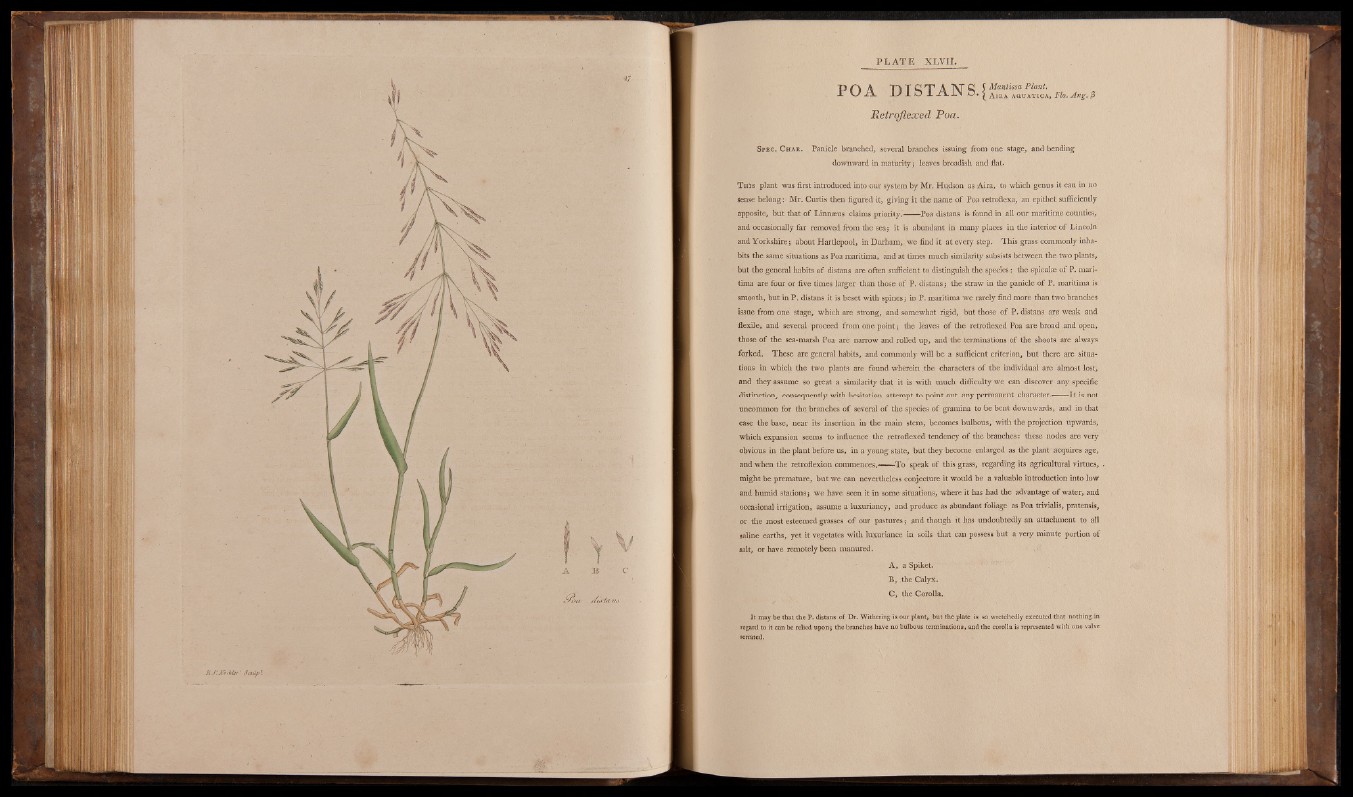
PLATE XLVII.
T )A A f \ T C T A "\T Q f Mantissa Plant, -*• -**■ AX A O A J \ . i-N O. ^ A i r a a&u a t i c a , Flo. Ang. /3
Retroflexed Poa.
Spec. Char. Panicle branched, several branches issuing from one stage, and bending
downward in maturity ; leaves broadish and flat.
T his plant was first introduced into our system by Mr. Hudson as -Aira, to which genus it can in no
Sense belong: Mr. Curtis then figured it, giving it the name of Poa retroflexa, an epithet sufficiently
apposite, but that o f Linnaeus claims priority7------Poa distans is found in all our maritime counties,
and occasionally far removed from the sea3 it is abundant in many places in the interior of Lincoln
and Yorkshire; about Hartlepool, in Durham, we find it at every step. This grass commonly inhabits
the same situations as Poa maritima, and at times much similarity subsists between the two plants,
but the general habits o f distans are often sufficient to distinguish the species: the spiculae of P. maritima
are four or five times larger than those of P. distans; the straw in the panicle of P. maritima is
smooth, but in P. distans it is beset with spines; in P. maritima we rarely find more than two branches
issue from one stage, which are strong, and somewhat rigid, but those of P. distans are weak and
flexile, and several proceed from one point| the leaves of the retroflexed Poa are broad and open,
those o f the sea-marsh Poa are narrow and rolled up, and the terminations of the shoots are always
forked. These are general habits, and commonly will be a sufficient criterion, but there are situations
in which the two plants are found wherein .the characters of the individual are almost lost,
and they assume so great a similarity that it is with much difficulty we can discover any specific
distinction, consequently with hesitation attempt to point out any permanent character.—... -It is not
uncommon for the branches o f several of the species of gramina to be bent downwards, and in that
case the base, near its insertion in the main stem, becomes bulbous, with the projection upwards,
which expansion seems to influence the retroflexed tendency of the branches: these nodes are very
obvious in the plant before us, in a young state, but they become enlarged as tire plant acquires age,
and when the retroflexion commences.------ To speak of this grass, regarding its agricultural virtues,
might be premature, but we can nevertheless conjecture it would be a valuable introduction into low
and humid stations; we have seen it in some situations, where it has had the advantage o f water, and
occasional irrigation, assume a luxuriancy, and produce as abundant foliage as Poa trivialis, pratensis,
or the most esteemed grasses o f our pastures 5 and though it has undoubtedly an attachment to all
saline earths, yet it vegetates with luxuriance in soils that can possess but a very minute portion of
salt, or have remotely been manured.
A, a Spiket.
B, the Calyx.
C, the Corolla.
It may be that the P. distans of Dr. Withering is our plant, but the plate is so wretchedly executed that nothing-in
regard to it can be relied upon; the branches have no bulbous terminations, and the corolla is represented with one valve
serrated.